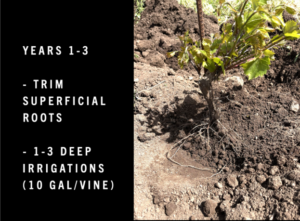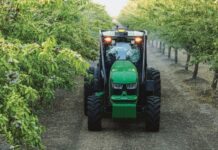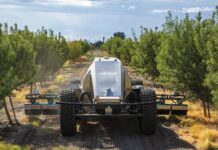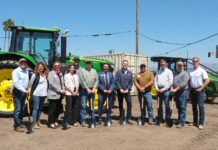
For three years in the early 2020s, drought reduced yields for the wine industry, with decreases ranging from 10% to 30% in some cases. Some wondered if dry farming could be an alternative.
That was the case at Pine Ridge Vineyards in Napa where the team was embarking on a replant. Like many who had never dry farmed before, they wondered how to set up their vines for dry farming success.
“Why we are going into dry farming is because we all are seeing the weather change,” said Gustavo Avina, viticulture director at Pine Ridge Vineyards, at a recent Napa Green educational session on dry farming. “There is more limitation on water than ever,” he said. “We’ve gotten a lot of water and rain [recently], but who knows what will happen in two or three years.”
Now, after two years of replanting a new vineyard for dry farming and seeing dramatically increased root depth, Avina said, “I think preparing a new vineyard for dry farming is the best way to go.”
Avina and Pine Ridge Vineyards Estate Winemaker Josh Widaman connected with dry farming expert Tod Mostero, director of viticulture and winemaking at Dominus Estate in Napa, under Napa Green’s mentorship program. Mostero has been dry farming the Dominus site in Napa’s Yountville appellation for 17 years.
Said Mostero, “When a vine is deeply connected to a place, it converts the energy of the sun to sugar that feeds microorganisms deep within the soil, creating an extraordinarily stable system. This buffers it from extremes and allows for consistent wine production each year.”
Terroir Payoff
Working in a high-end Napa estate headed by a famous French vintner, Mostero also made the case for dry farmed wines as the true expression of terroir.
“I love wine that resonates with balance, connecting you to everything and leaving you breathless,” said Mostero, who works for world-class Bordeaux and Napa vintner Christian Moueix. New release wines from Dominus sell for more than $300.
Dry farming is key, he said, driving roots deep into the soil where they can find minerals, nutrients and moisture.
Widaman said dry farming offered the potential to weather ups and downs.
“I think in a young winegrowing region such as ourselves, where we’ve only been around realistically on the world map for about 50 years,” he said, “we’re just now starting to think… [about] providing a vineyard that has the kind of resiliency and durability that… we need in our watershed as well. But a vineyard that provides the style of wine, that has that tension, that interest, that depth, is what we need to continue to create wines that are in the world pantheon.”
Site, Soils and Drainage
Mostero described a common soil and landscape situation in Napa Valley vineyards ranging from sloping sites with well-draining soils to heavy clays in valley bottoms.
“Many classic Napa vineyards were dry farmed and planted on alluvial fans because of well-draining soil over impervious clay layers. Winter rainwater stored in the mountains percolates through, hits the clay and flows under the vineyard as springs, providing the vineyard with water throughout the dry summer months.”
“Alluvial fans have gravelly soils on the upper benchlands, transitioning to heavier clay toward the valley center. I’ve seen examples of dry farming in all those soil types,” he said.
The site Pine Ridge selected was a 24-acre, no-till property that Avina described as the warmest site the team farms.
Different soil types affect dry farming, Mostero said.
“In gravelly soils, water drains early in the spring, and vines adapt by producing less vegetation. Heavier clay soils retain more water in spring, leading to more vegetation and increased water consumption. These soils dry out quickly in summer, making dry farming more challenging,” he said.

Year One: Hole Preparation and Limited Watering
Preparation is critical.
“What happens when you dry farm,” said Mostero, “is you condition your roots to grow deeply into the ground and explore more space.”
“The first thing for me to do before we plant the vine is to prepare the ground well enough, breaking the hard pan below the surface,” said Avina. “So that would help the roots to grow deeper. After you prepare your vineyard and you are planting the vine, I want to make sure my guys dig the holes deep enough that they can bury the entire vine.
“We make a mistake when we just make the hole big enough where the vine can fit in there… Below the roots, there is hard pan. If you make a hole wide enough and deep enough, that will help the roots to grow deeper as what we did in there.”
The vines were irrigated heavily, with 10 to 12 gallons, but only four times in the year, Avina said.
Said Mostero, “In the first couple of years of vine establishment, we irrigate infrequently but deeply. This encourages deep root growth as the surface soil dries out between irrigations, preventing horizontal root growth. This is fundamental in the first couple years.”
Avina said they used spaghetti emitters in year one but removed them after year one, using only emitters at the site of the vine in year two.
After one year, it was time to see if the vines needed more water to get established. Out came the shovels.
Avina estimated the vines might be six inches deep.
The team, including Mostero, was surprised to see roots reaching a depth of two to three feet.
Mostero stressed there is no one formula. Digging into the soil to see the actual root development is the only way to assess the impacts of dry farming on root development.
“In mid-summer, when everything was dry, we found moisture and thick roots plunging deep. Even experienced viticulturists are surprised by this. It reminds us that sometimes the simplest tools like a shovel are the best,” he said.

Year Two: Cutting Superficial Roots
In year two, Mostero recommended clipping the upper portion of the roots, a technique that was new to the team. By eliminating the superficial roots, the plant went deeper into the ground.
Initially costs were a concern, Widaman said, but technology provided help.
“I think a big worry for us because we’re part of a publicly traded company is always cost, and from a business case, how we would justify that labor,” Widaman said. “But in the end, the added people hours that it took to do that work wasn’t as significant as we were originally worried about.”
The team used an old French plow to help cut the superficial vines, reducing labor costs, Avina said.

Next Steps
Convinced by their two years of positive experiences in dry farming, the Pine Ridge team is planning to implement the practice in 60 to 100 acres of replantings on a wide variety of sites in Napa, Avina said.
“Right now, we have three vineyards that are set up for retirement,” he said. “And my thinking is, in the next eight years, we are planning to replant most of our vineyards, and the idea is that they will be dry farmed.”
The company has a total of 160 acres. “That is not so many,” Avina said, “but we have 10 different sites from Carneros to Howell Mountain. And eventually all those will be set up for dry farming.”
Mostero calculated dry farming on 100 acres could save 10 million gallons of water a year.
• 10 gallons per vine
• 1,000 vines/acre
• 100 acres
• = 10 million gallons of water
Assumptions:
• 1 irrigation = approximately 10 gallons per vine
• 10 irrigations per season
• At a density of 1,000 vines per acre, 1 irrigation = 10,000 gallons per acre
• 1 irrigation on 100 acres = 1 million gallons
• 10 irrigations per season = 10 million gallons











